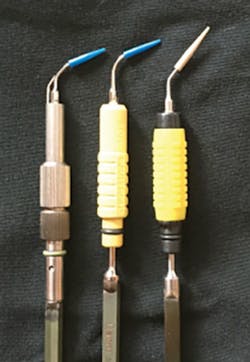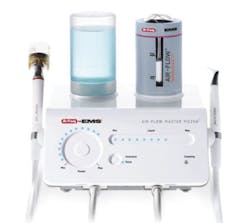Power off biofilm on implants: Instruments address the challenges in the implant environment
By Nancy Miller, RDH, BA
Biofilm is Enemy Number One when it comes to dental diseases. It lurks in a patient's sulci, creating a low-grade inflammatory process potentially leading to an acute full-blown infection. It is actively in cahoots with carbohydrates in the mouth, leading to acidic challenges on tooth surfaces and demineralization.
Biofilm is the culprit in dental diseases. Add biofilm challenges to the oral implant environment, and you could have a problem with peri-implant mucositis, peri-implantitis, peri-implant cementitis, and potential implant failure.
To contend with hard calculus deposits or excess cement on and around implants, a great variety of hand instruments have been designed to accomplish hard deposit removal during maintenance. A variety of power inserts also attend to this hard deposit removal. While biofilm gets disrupted with any manipulation within the pocket and on the tooth surface with hand or power inserts, research is showing that the most efficient way to disrupt the biofim is via air flow therapy, or what has been known in the past as air polishing.1 Let's explore what's available today in power implant maintenance.
Magnetostrictive Implant Inserts
The first magnetostrictive implant insert was the ITS (Implant Titanium Scaler), created by engineer Tony Riso and sold through his company of the same name over 25 years ago. It consists of a traditional straight, nickel-stacked insert with a special working end with wrenched-on blue plastic protective points. These points can be autoclaved until wear indicates their disposal and replacement. The ITS scaler is available today via Madultrasonics.com, a company founded by Tony Riso's dental hygienist consultant, Madalyn Rosenbluth.
Several other companies have created their own version of the magnetostrictive plastic protective tip. Dentsply has the SofTip with blue plastic points wrenched onto its straight insert similar to the ITS. Parkell has the GentleClean, which is a polyetherimide resin screw-on point on a special insert.
The latest entry to the market is Premier Dental's Big Easy Implant Tip, which has a permanently affixed plastic point on a straight insert that is made of very hard biomedical PEEK polymer plastic. This PEEK plastic does not shred when in contact with the threads on an implant as the softer blue plastic tips can. There is research to show that the shreds left in the sulcus can create irritation and could contribute to peri-implantitis.2
All of these inserts were created not only for implant maintenance but also for those patients where sensitivity is a concern. The plastic tips allow for deplaqueing on sensitive areas and the PEEK varieties can actually remove hard deposits. The use of any of these magnetostrictive inserts around implants is limited due to access issues concerning the width of the tip when placed subgingivally.
Piezoelectric Implant Inserts
In the piezoelectric implant scaler tip offerings, Hu-Friedy-EMS has the PI system consisting of an endo chuck holding a wrenched-in special insert made of PEEK polymer plastic. The points can be autoclaved numerous times before replacement is necessary. NSK/Brasseler has the V-Tip, which similarly fits into an endo chuck and is made of "a special material," according to the company's website. The newest entry into the piezo market is Acteon Satelec's Implant Protect Titanium Metal Implant tip set.
Different styles of insert tips are displayed: ITS, SofTip, and Big Easy.
Hu-Friedy-EMS Air-Flow MasterPiezon unit
Coltene's Biosonic SUVI
This article is about availability of power implant maintenance tools, not the technique for usage. I must confess I have had a great degree of difficulty inserting the magnetostrictive offerings into an implant area sulcus, and I have had better success with the piezoelectric tips I have tried, but still limited. I have not tried the new Satelec titanium inserts, but they do look more promising for accessibility.
Air Polishing
What I have found to be very promising is the use of power air polishing with glycine powder around the implant area for biofilm removal. Research is showing that this method is just as effective as hand plus ultrasonic instrumentation, but that it is much more efficient and less time consuming.3
My personal experience with this method has been very satisfying in terms of accessibility and maneuvering of the spray into the sulcus and around the entire implant area. I feel that the air/water/powder slurry "lifts" or deflects the soft tissue surrounding the bottom of the implant crown, facilitating debridement of those surfaces that contact the gingivae. Implants with abutments that are longer, creating pseudo pockets, are easy to debride using the pressurized glycine slurry.
Several companies have devices that allow for the smaller particles of glycine powder (an amino acid powder that is 25 microns as opposed to standard sodium bicarbonate particles that are 65 to 85 microns) to be propelled into the implant area without distressing the titanium surface or the gingivae.4
The secret is in the powder particle size and the air pressure and chamber of the device propelling that powder. I compare it to the analogy of being pressure washed with large particles of kosher salt as opposed to tiny particles of cornstarch. Which substance will sting and abrade more?
Hu-Friedy-EMS has several units that will accommodate this smaller particle. Glycine can be used in the units with the standard handpiece nozzle and directed at the gingival margin without distress.
Hu-Friedy-EMS also has a special flexible disposable Perio Nozzle that can be used on two of their devices' special handpieces. This nozzle safely directs the glycine powder to the depth of the pocket for more complete biofilm removal.5
Acteon-Satelec has the Air-N-Go unit that allows for glycine powder use as well as regular bicarbonate powder by interchanging the handpiece nozzles and powder chambers.
Coltene has its Biosonic SUVI combo unit that has an air polisher with a special subgingival nozzle.
If the device is not intended for glycine powder, it should not be used as it could clog the device and invalidate its warranty. For those who utilize the Dentsply Cavi-Jet, this is especially true, since the air pressure in these units is set much higher than the PSI recommended for use subgingivally. Care must also be taken to ensure that bicarbonate larger-sized particles do not linger in any multiuse chambers or they could damage softer titanium surfaces.
My experience with using an air polisher with the smaller glycine particles around implants has been very gratifying. While not meant to be a scientific analysis, I can give you my practical analysis. On my Hu-Friedy-EMS Air-Flow Master unit, even the use of the universal handpiece nozzle with glycine powder directed into the peri-implant area has been well received by my patients. It also satisfies my desire to provide complete and advanced treatment. Directing the pressurized glycine powder under and around the implant prosthesis also debrides biofilm from the soft tissue wall in a more complete fashion. My experience shows that this is accomplished in about one quarter of the time it takes to debride with an ultrasonic tip and even less time than with a hand instrument. Research also backs up my clinical experience.6,7 This is in reference to biofilm, not hard deposits, which still need to be removed by a hand or ultrasonic instrument.
To summarize, implant maintenance today is facilitated by several innovative and practical power modalities. Magnetostrictive and piezoelectric scaler tips allow for safe and gentle contact with the titanium surfaces without damage. New therapy with air polishers and glycine powder is proving to be very effective and efficient in the maintenance of implants. These weapons assist us in the battle against biofilm. RDH
Nancy Miller, RDH, BA, has, since 1992, presented lectures and hands-on courses on topics such as ultrasonic instrumentation and air flow therapy for biofilm removal, ergonomics, assisted hygiene, and periodontal and caries disease treatment through her company Ultraconcepts. She still practices two days weekly in a general practice in Green Bay, Wis. She also has been a dental practice management advisor with Jameson Management since 1998, specializing in clinical department coordination with the business team. Nancy is also product evaluator for several manufacturers including Crown Seating, Hu-Friedy, Perioptix, and Florida Probe.
References
1. Graumann S, Sensat M, Stoltenberg J. Air-polishing: A review of current literature. J Dental Hygiene. 2013; 87:173-180.
2. Hempton T, et al. Dimensions of Dental Hygiene. January 2011; 9(1): 58-61.
3. Graumann S, Sensat M, Stoltenberg J. Air-polishing: A review of current literature. J Dental Hygiene. 2013; 87:173-180.
4. Cochis A, Fini M, et al. Effect of air polishing with glycine powder on titanium abutment surfaces. Clin Oral Implants Res 00, 2012 1-6 doi: 101111/j.1600-0501. 2012. 02490.x.
5. Flemmig T, et al. Randomized controlled trial assessing efficacy and safety of glycine powder air polishing in moderate to deep periodontal pockets. J Periodontal 2012; 83: 444-452.
6. Wennstrom JL, et al. Subgingival debridement of periodontal pockets by air polishing in comparison with ultrasonic instrumentation during maintenance therapy. J Clin Periodontol 2011; 38: 820-827.
7. Moene R, et al. Subgingival plaque removal using a new air polishing device. J Periodontol 2010; 81: 79-88.




